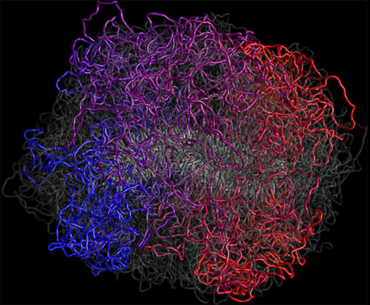Below is the online edition of In the Beginning: Compelling Evidence for Creation and the Flood,
by Dr. Walt Brown. Copyright © Center for Scientific Creation. All rights reserved.
Click here to order the hardbound 8th edition (2008) and other materials.
33. Genetic Information

Figure 15: The Third Dimension. Shown above is an artist’s representation of the DNA (totaling 7 feet in length) which is stuffed inside the nucleus in each of about 30,000,000,000,000 (thirty trillion) cells in your body. Each color represents the DNA in one of 23 pairs of chromosomes. The amount of information in that DNA is staggering; it is the equivalent of about 4,000 books.a For a human, 3 billion lettersb must be precisely sequenced. (Imagine the total information in all animals and plants.) Each strand is folded in three-dimensional shapes (or loops) that bring tiny segments of DNA close to other segments with which they must interact. Amazingly, the folding is different for each type of cell in your body! Before a cell can divide, this DNA must be refolded into two separate cylindrical shapes, all without tangling.c (Refolding takes about 15 minutes.) Although this has been filmed,d how it happens and functions almost flawlessly is currently unknown.e Complexity is superimposed upon complexity—all within a volume that is less than one ten-thousandth the size of a grain of sand!f
How could any reasonable person claim that this unfathomable complexity arose by chance through natural processes (in other words, evolution)—even over billions of years? Clearly, it is irrefutable evidence of a Designer Whose intelligence is beyond our comprehension!
Natural processes cannot produce large amounts of information. The genetic information in the DNA of each human cell is roughly equivalent to a library of 4,000 books.a
Even if matter and life somehow arose—perhaps only a bacterium—the probability that mutations and natural selection produced this vast amount of information is essentially zero.g It would be similar to producing 4,000 books with the following procedure:h
a. Start with a meaningful phrase.
b. Retype the phrase, but add letters and make some errors.
c. See if the new phrase is meaningful.
d. If it is, replace the original phrase with it.
e. Return to step “b.”
To produce just the enzymes in one organism would require more than 1040,000 trials.i (To begin to understand how large 1040,000 is, realize that the visible universe contains fewer than 1080 atoms.)
In 1972,j evolutionists, out of ignorance,k began referring to large segments of DNA as “junk” DNA, because it supposedly had no purpose and was left over from our evolutionary past. What evolutionists called “junk” DNA is now known to contain millions of switches that regulate gene activity at specific times and in unique ways for each of thousands of different types of cells. Most genetic changes that cause disease lie outside the genes and on the 95% of the DNA that evolutionists used to call “junk.”l
In humans, 2,000 genes are “indispensable for viability.” They are required “for basic cellular functions such as cell division, transcription, translation, DNA replication, cycle control, and fundamental metabolism.”i Suppose, after millions of years, 1999 of these essential genes had evolved, but one had not yet evolved. What would have happened? Extinction! Human evolution would have had to start all over again. Life’s complexity is mind boggling—not something that random processes could ever produce. Obviously, all 2,000 had to come into existence simultaneously. But that is creation!
Based on all known experience—scientific or otherwise—information comes only from intelligence. Vast amounts of information require a vast intelligence.